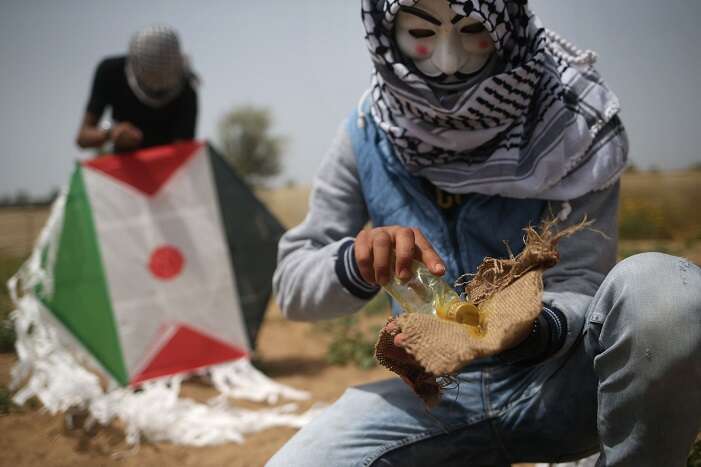Several large fires were sparked Wednesday as a result of kites fitted with firebombs that were sent over the Gaza border into Israel by Palestinian demonstrators.
Incendiary kites are the latest terrorist measure used by Palestinians rioting near the security fence to harass Israeli troops and the residents of the Israeli border-adjacent communities.
Dozens of fires have been sparked over the past three weeks in wooded areas and on agricultural land near the border as a result of kites fitted with crude incendiary devices.
The IDF, Israel Fire and Rescue Services, Jewish National Fund foresters and local farmers are making every effort to combat this phenomenon together, but hundreds of acres have already been lost to terrorist fires.
Three of these flying firebombs set a massive fire in the forest bordering Kibbutz Be'eri, 3 miles from Gaza. Wednesday's blaze was the largest fire since the terrorist "kite campaign" began.

Ten firefighting teams battled the flames that, fueled by high temperatures, dry weather conditions and strong winds, raged for more than three hours, the Israel Fire and Rescue Services' Southern District said.
Firefighters finally extinguished the blaze at around 8 p.m., but not before it reduced dozens of acres of woodland into ash.
Several smaller fires erupted in agricultural fields in several Israeli communities near the border, devouring acres of crops before farmers were able to extinguish them.
No injuries were reported in any of the fires.
Sdot Negev Regional Council head Tamir Idan warned that kite terrorism was becoming a trend and demanded that the military devise ways to counter the threat.
"This kind of terrorism is life-threatening," he said. "We are not taking it lightly. We understand that it's very problematic and that there's no way to eliminate it completely, but the IDF is trying all sorts of things and I hope they find a solution."
Idan, along with Shai Hajaj, head of the Merhavim Regional Council, leveled criticism at Israeli and Palestinian human rights groups that recently appealed to the High Court of Justice, asking to restrict the Israeli response rioting on the Gaza border.
At least 45 Palestinians have been killed and thousands have been wounded since the weekly protests near the security fence, orchestrated by the Hamas terrorist group, began on March 30.
The Palestinians have accused the Israeli military of using excessive force against "unarmed, peaceful protesters," but the IDF maintains that for the most part, it uses standard crowd control measures, resorting to live fire only to neutralize terrorist attempts to breach the fence, plant explosives on the border, or carry out terrorist attacks under the cover of the demonstrations.
"While the High Court in Jerusalem hears petitions seeking to curb the measures used by Israeli soldiers in the face of Gaza rioters trying to breach the security fence, they [rioters] keep setting agricultural lands on fire," Idan and Hajaj said in a joint statement.
"These human rights groups and the judges would be wise to remember that hurling rocks and torching fields are acts of violence. This type of violence causes immeasurable financial damage but also threatens human lives," the statement said.
"The use of incendiary kites to set fields on fire is no longer limited to Palestinians rioting near the border on Friday. It has become a daily occurrence. We demand that the IDF put a stop to it," the statement concluded.
Avigdor Kalifah, the agricultural director for the Negev communities, said that over 85 acres of crops have been destroyed so far, causing farmers significant financial damage.
"Just as agricultural terrorism has been gaining attention, I hope kite terrorism will also become part of the public agenda," he said.
He called the Palestinians' kite terrorism "torture," saying, "If they want to burn the fields, they may as well set them all on fire at once."
Meanwhile, the success of kite terrorism has apparently inspired the Palestinians to find a better way to set fires even farther from the border.
Images posted on social media Wednesday showed Palestinians arming large helium-filled balloons with incendiary materials.
One of the posts noted that unlike kites, incendiary balloons do not need a handler to steer them in the right direction and can be launched from anywhere in the Strip, and they can also remain airborne for a longer period of time and therefore travel further into Israel.



